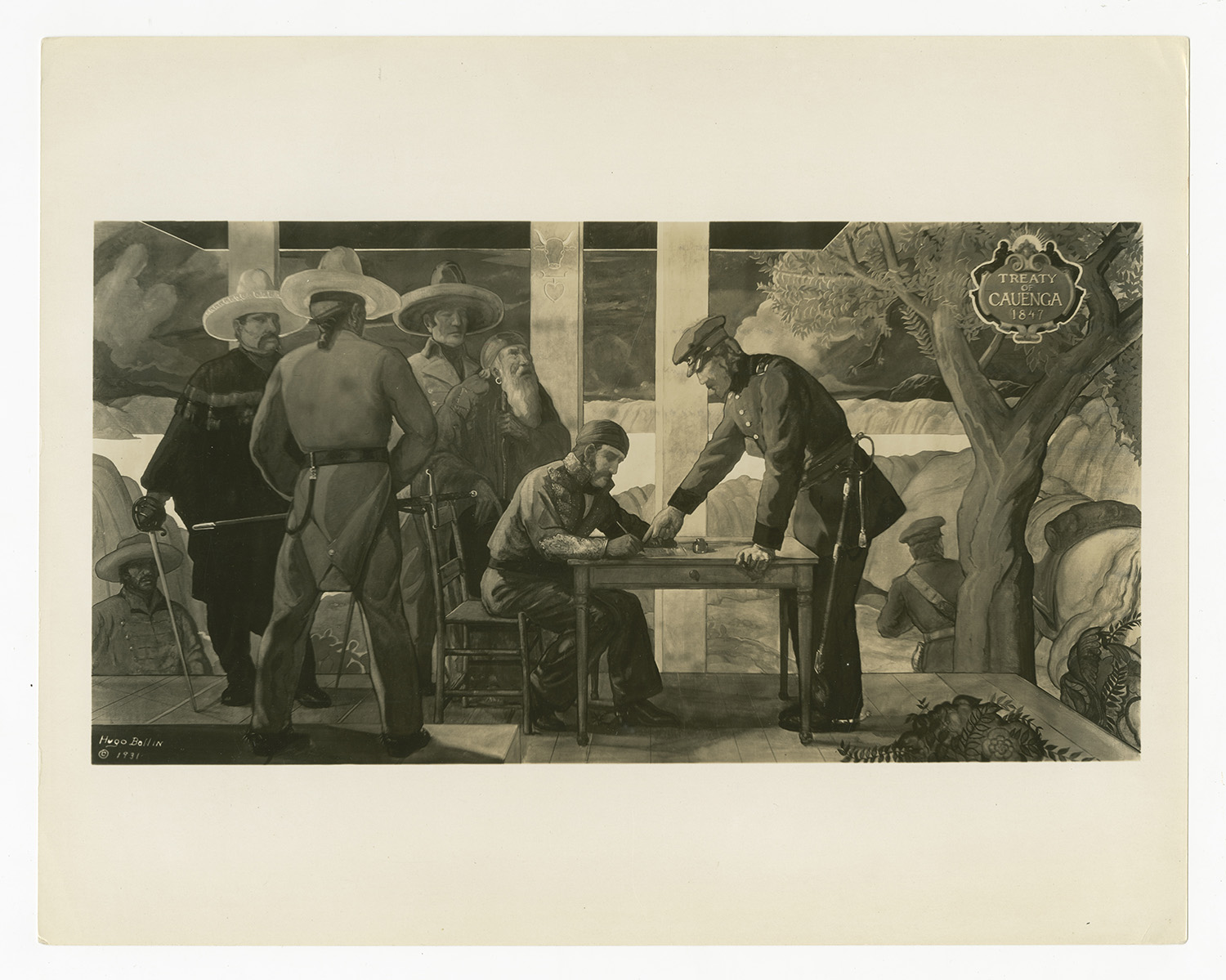Title Guarantee and Trust Building - The Treaty of Cahuenga, 1847

- In Ballin's Words
- Allegory and History
- Cinematic Influences
- Source/Citations
Ballin described his murals at the Title Guarantee and Trust Building in a pamphlet published in 1931:
“One of the important decisions in California history was made in early 1847 over a table on the veranda of a small ranch house that then stood near Cahuenga Pass.
“One of the important decisions in California history was made in early 1847 over a table on the veranda of a small ranch house that then stood near Cahuenga Pass.
This event - the signing of the Treaty of Cahuenga whereby the Mexican forces surrendered to the American – is celebrated in the third panel executed by Hugo Ballin.
In this panel Generals Pico and Fremont play leading roles. The former, Andres Pico, was the rough-and-ready leader of the Mexican army, a man who had swept the United States troops into an overwhelming defeat in the San Pasqual Valley with his horsemen recruited from the ranchos. The signing of the articles that ended the hostilities had followed the last military maneuver, that of Stockton and Kearny marching north from San Diego and John C. Fremont marching south to meet them. The Stockton-Kearny forces had engaged two minor battles at the San Gabriel River and at La Mesa, entering Los Angeles thereafter without opposition. With the war over, the American flag was to float over Los Angeles, the bands were to march and play, and the rank and file were again to be happy. In the panel, Fremont, the ‘Pathfinder’ is telling Pico where to sign. Behind the latter stand several Mexican officers.”
Here Ballin depicts a triumphant version of Los Angeles' transition to becoming an American state, casting that transition as dignified and disciplined, when in reality, claims to land and resources were hotly contested for decades after the Treaty of Cahuenga. Some Anglos unlawfully seized land from those holding disenos (land grant contracts issued by the Mexican government), others refused to recognize their legitimacy, and real estate speculators and squatters often flouted existing property claims. That Ballin would offer such an orderly and diplomatic version of events was likely in part to please his corporate patrons from the Title Guarantee and Trust company. The company's founder, Edwin Sergeant, had been among the first individuals in Los Angeles to issue authoritative titles to real estate holdings using legal documents from both the Mexican and Spanish governments to support land claims from the days of Spanish and Mexican rule. Indeed, the new building had been designed to house the over 1.1 million titles to parcels of land in Southern California held by the company, including a “Book of Disenos” (a survey of Mexican land grants) and records of the acts of the Mexican Ayuntamiento (Council) that preceded the American government. Those documents served as the mechanism through which American understandings of property rights and land ownership had been realized in the region, “guaranteeing” not only individual land claims but also Anglo-American hegemony in Southern California more broadly.1 By depicting the transition to American rule in this way, Ballin thereby celebrates the company's purpose and reifies its role in establishing American rule, and supporting the development, strength and vitality of the city of Los Angeles.
Like the panel of the "The Spanish Period" Ballin depicts a sharp contrast between the Mexican characters in this panel and the Anglo ones. He does so using costumes, a technique he borrowed from his career as a filmmaker. The Mexican soldiers are depicted in serapes with sombreros, signifying their status as Mexicans, while the American soldiers wear uniforms denoting their rank. They appear as an ad-hoc group of "rough-and-ready" fighters, rather than a disciplined army of professional soldiers, suggesting the inevitability of their defeat. Fremont stands instructing General Pico about the treaty he is signing, signaling that American leaders had to teach the Mexicans how to conduct orderly, civilized diplomacy. The panel underscores the "Spanish fantasy past" by suggesting the idea that the United States was justified in taking over the region because Americans brought order and stability that the Mexican state was incapable of providing.
Image courtesy of Department of Special Collections, Charles Young Library, University of California Los Angeles.
Appears in the Hugo Ballin Papers, collection number 407, Box 17, Folder 1.
Ballin's quotation appears in his pamphlet, "Murals in the Title Guarantee Building," (Los Angeles: Title Guarantee and Trust Company, 1931).
1. Los Angeles Times, Aug. 4th, 1929 and May 31st, 1931.
| Previous page on path | Title Guarantee and Trust Building - Gallery, page 3 of 6 | Next page on path |

Discussion of "Title Guarantee and Trust Building - The Treaty of Cahuenga, 1847"
Add your voice to this discussion.
Checking your signed in status ...